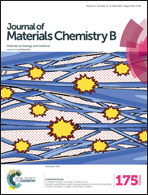Examining the elemental contribution towards the biodegradation of Mg–Zn–Ca ternary metallic glasses†
Abstract
The Mg–Zn–Ca metallic glass system has been the focus of recent studies as a prospective material for biodegradable implants. To date, the influence each alloying element has on the degradation behaviour of this class of alloy is still not well understood. This study employs electrochemical polarisation and in situ impedance spectroscopy coupled with H2 gas collection in simulated body fluid at 37 °C to elucidate the mechanisms by which a series of custom produced Mg–Zn–Ca metallic glasses degrade compared with high purity Mg. The results show that Mg–Zn–Ca metallic glasses provide significantly more noble corrosion potentials and suppressed hydrogen gas evolution relative to high purity Mg. Furthermore, the role each element has in degradation was investigated systematically by varying the concentration of each alloying element. Testing revealed that the complex nature of dissolution in metallic glasses requires testing beyond solely polarisation and hydrogen gas collection to elucidate degradation behaviour in vitro. Practical limits to which the composition may be adjusted in this ternary alloy system, so as to maintain minimal degradation, have been achieved.


 Please wait while we load your content...
Please wait while we load your content...